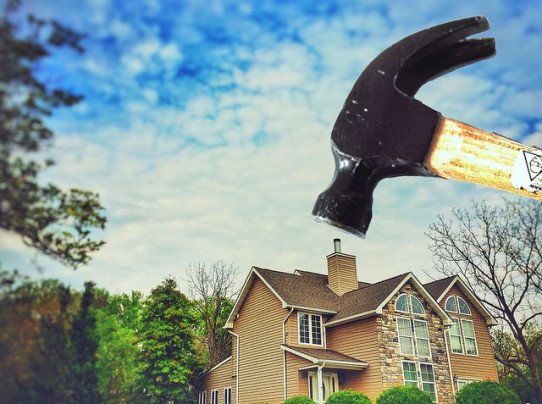Mortgage lenders surveyed by Fannie Mae in November say credit standards across all loan types eased during the previous three months and should continue to over the next quarter. The fourth quarter 2016 Mortgage Lender Sentiment Survey found lenders concerned about recent mortgage rate increases but generally optimistic about the availability of mortgage credit. Looser credit is good news for prospective home buyers who may be concerned that they won’t be able to qualify for a mortgage, as it generally means lending requirements become more lenient. But despite credit standards loosening, Doug Duncan, Fannie Mae’s senior vice president and chief economist, says the recent spike in mortgage rates presents a challenge after years of interest rates hovering just above record lows. “Rates could slowly unwind in coming quarters, reversing some of the expected decline in volume,” Duncan said. “However, the potential normalization of interest rates after a sustained period of strong refinancing volumes presents the biggest business challenge facing mortgage lenders in some time.” In other words, there’s no telling if rates will stay up but, if they do, it could affect the number of Americans entering the mortgage market in the coming months. More here.
Archive for December 2016
Top Tips For Selling Your House Quickly
Selling a house can be an emotional experience. On the one hand, you’re moving and eager to get started on a new and exciting chapter of your life. On the other, you’re leaving a place where you’ve made memories and developed attachments. So the last thing you want, once you’ve put your home on the market, is to find it isn’t popular with buyers. But how can you make sure your house attracts qualified buyers who are ready to make an offer? Among the tips experts often offer home sellers, pricing it right always tops the list. Prospective home buyers are, first and foremost, looking for something that fits their budget. After all, it’s going to be easier for a buyer to bend on whether or not their new home has granite countertops in the kitchen than it will be for them to stretch their budget an extra $50,000. If you’re in no rush, price your home high and see what happens. However, if you want to move more quickly, price it to sell. Other less obvious tips include making sure you’ve got great photographs. These days, buyers are bound to browse available homes online. Make sure, when they find yours, it looks as good as it can. Don’t underestimate the power of great images. You can also put your best foot forward with a fresh coat of paint, a serious decluttering, and the removal of pet paraphernalia. More here.
Builder Survey Hits Highest Level In 11 Years
There are a number of perspectives from which you could view the housing market. That’s why there are surveys gauging the attitudes of buyers and sellers, as well as Realtors, mortgage lenders, and builders. Each has an unique take on the real estate market that is based on their specific role. For example, an agent may have a very different understanding of their local market than the average home buyer, if only because of their experience and expertise. Builders are considered an important measure of the market because they have a ground-level view of how many people are shopping for new homes, the challenges facing builders, and the amount of foot traffic they’re currently seeing. For this reason, the National Association of Home Builders’ Housing Market Index surveys builders each month and scores their responses on a scale where any number above 50 indicates more builders view conditions as good than poor. In December, the index hit 70, its highest reading since July 2005. Robert Dietz, NAHB’s chief economist, says this month’s increase may have more to do with the recent election than any fundamental change in conditions. Still, Dietz says the market looks good. “Though this significant increase in builder confidence could be considered an outlier, the fact remains that the economic fundamentals continue to look good for housing,” Dietz said. “The rise in the HMI is consistent with recent gains for the stock market and consumer confidence. At the same time, builders remain sensitive to rising mortgage rates and continue to deal with shortages of lots and labor.” More here.
Mortgage Rates Continue Climb Upward
Though they didn’t move much, average mortgage rates were up again last week, according to the Mortgage Bankers Association’s Weekly Applications Survey. The survey found rates increased from one week earlier for loans backed by the Federal Housing Administration and 30-year fixed-rate mortgages with both jumbo and conforming balances. Mortgage rates were down slightly for 15-year fixed-rate loans. Increasing rates continue to have a negative effect on refinance demand – which is generally more sensitive to rate fluctuation. In fact, the refinance index fell 4 percent from the week before, while demand for loans to buy homes dropped 3 percent. At this time last year, refinance demand was 12 percent higher than it is now. Purchase applications, on the other hand, are still outperforming last year’s numbers, rising 2 percent higher than they were during the same week last year. The number of Americans requesting applications to buy homes may be falling because of higher mortgage rates, though it’s also likely due to a lower-than-normal number of homes available for sale and prices that have returned to their pre-crash peaks in many markets. The MBA’s weekly survey has been conducted since 1990 and covers 75 percent of all retail residential mortgage applications. More here.
Home Buyers Say The Bigger The Better
Owning a home is a big draw for buyers. In fact, recent data from the National Association of Realtors shows 31 percent of all buyers said they were purchasing a house because they wanted to own. Among first-time buyers, that number shoots up to 67 percent. Obviously, the dream of ownership is alive and well. But the second most common reason buyers cited when asked why they were purchasing a home was because they wanted something bigger. And the number of buyers who say they need a larger home is rising. According to economist Amanda Riggs, there are a couple of reasons for this. One is the number of homeowners who have been waiting to sell as home prices rebounded from the housing crash. These homeowners may have built up enough equity over the past few years to now afford something bigger. The other part of it is the fact that the largest share of home sellers last year were between the ages of 35 and 44. “We can speculate that the sellers probably had a child in the last few years and wanted a bigger home to expand their family,” Riggs writes in a post for the NAR’s Economists’ Outlook Blog. Whatever the reason – whether it’s boosted equity or a growing family – Americans have consistently shown that, when it comes to their homes, bigger is better. More here.
The Number Of Fixer-Uppers For Sale Rises
The number of homes for sale that are described as “fixer-uppers” is on the rise – which is good news if you’re a homeowner that hopes to sell your house “as is” or a buyer looking for a project. The analysis, done by Zillow, found that, over the past five years, there’s been a 12 percent increase in the number of homes on the market that’ll require some extra love from their new owners. They also found that the trend is more pronounced on the higher end of the market, with a 35 percent increase in the number of “fixer-uppers” among the top third of homes for sale compared to a 3 percent increase among more affordably priced homes. So why are more homes being listed “as is”? Simply put, the increase is due to low inventory. With fewer houses for sale, homeowners in many markets feel more comfortable listing their homes without having done every repair and renovation because buyers have fewer choices. Svenja Gudell, Zillow’s chief economist, says there are also more older homes out there. “Sellers are in the driver’s seat, with the freedom to list their home for sale ‘as-is’ without worrying about price cuts or the home sitting on the market,” Gudell said. “And without sufficient new construction, the housing stock has aged, so home buyers are finding more and more homes on the market in need of a little TLC.” More here.
Survey Asks Americans About Housing Market
Fannie Mae’s monthly Home Purchase Sentiment Index tracks Americans’ feelings about buying and selling a home, prices, mortgage rates, household income, etc. In November, the survey saw its fourth consecutive monthly decline, though it remains up slightly from where it was at the same time last year. Doug Duncan, Fannie Mae’s senior vice president and chief economist, says there was an uptick in consumer confidence and the number of respondents who said their income was higher than it was last year but, so close to an election, it’s hard to read too much into the results. “The November Home Purchase Sentiment Index outcome is difficult to interpret as the data collection period occurred across the presidential election timeline,” Duncan said. “The results are fairly evenly split between responses collected before and after the election, and there is evidence of an increase in consumer optimism in the immediate aftermath of the election. However, we caution readers against drawing conclusions about sustainable changes in consumer sentiment so soon after the election.” As an example, Duncan points to rising mortgage rates and how they could impact home purchase attitudes if sustained. However, because recent fluctuations in mortgage rates have been short lived, with rates returning to their prior position shortly after a spike, it may be too soon to say. In other words, Americans may feel uncertain but there isn’t yet reason to believe market conditions have fundamentally changed. More here.







